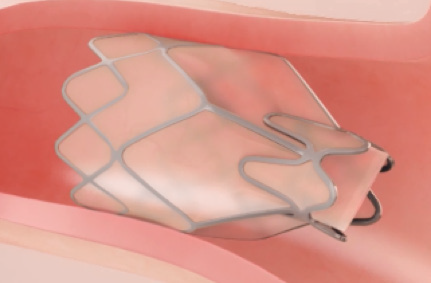Zephyr Valvue Treatment
for Patients with
Advanced Emphysema
About Emphysema
Emphysema is a form of Chronic Obstructive Pulmonary Disease commonly known as COPD. In severe emphysema, the walls of the air sacs in the lungs called the alveoli are weakened and rupture, creating larger air spaces – this is known as hyperinflation. When this occurs, the air sacs do not work properly, and inhaled air becomes trapped in the damaged areas. This causes the diseased parts of the lung to get larger and put pressure on the healthy parts of your lungs and diaphragm. As a result, you may find it difficult to breathe properly and take full, deep breaths.
Treatment Options for Emphysema
Emphysema cannot be cured, but the right treatment can help you breathe better, be more active, and improve quality of life. There are a few treatment options for emphysema and your doctor can help you determine which is best for you.
Non-surgical
- COPD medication: inhalers, oral steroids, antibiotics, or other prescription medications.
- Pulmonary rehabilitation –therapy to help you exercise your lungs and learn how to breathe more efficiently.
- Oxygen therapy – Emphysema reduces the amount of oxygen that can reach your bloodstream. Your doctor may prescribe oxygen therapy when medication is not doing enough for you.
Non-surgical
- COPD medication: inhalers, oral steroids, antibiotics, or other prescription medications.
- Pulmonary rehabilitation –therapy to help you exercise your lungs and learn how to breathe more efficiently.
- Oxygen therapy – Emphysema reduces the amount of oxygen that can reach your bloodstream. Your doctor may prescribe oxygen therapy when medication is not doing enough for you.
Surgery
- Lung volume reduction surgery – A surgeon will open your chest and cut out areas of damaged lung tissue, or large air spaces (bullae). This has been shown to improve patients’ breathing but has a high risk of side effects and death.
- Lung transplant – When the lungs are too damaged to benefit from surgery, certain patients may meet the criteria for lung transplantation surgery. Patients receiving this treatment must take immunesuppressing medications for the rest of their lives; however, the transplant also carries high risk complications such as organ rejection or death.
Zephyr Valve Treatment
Zephyr Valves are proven to help emphysema patients breathe easier, be more active, and enjoy a better quality of life1 Zephyr Valve treatment is not another medication or surgery that requires cutting or incisions. It is a procedure that places tiny valves in your airways which allow the healthier parts of your lungs to expand, thereby lifting pressure off the diaphragm and helping you breathe more easily.

Benefits
In the LIBERATE pivotal clinical trial, at one-year, the patients who received the Zephyr Valve experienced the following benefits compared to patients on medications alone.
- Breathe easier due to improved lung function
- Could do more exercise and walk farther
- Could do more daily life activities, such as walking, bathing, and gardening
- Enjoyed a better quality of life with more energy
- Felt more confident leaving their home
Risks
Complications of the Zephyr Endobronchial Valve treatment can include but are not limited to pneumothorax, worsening of COPD symptoms, haemoptysis, pneumonia, dyspnoea and, in rare cases, death.
Who cannot have the Zephyr Valve treatment?
You cannot have this treatment if you:
- Are unable to have a bronchoscopic procedure
- Have an active lung infection
- Have an allergy to Nitinol, nickel, titanium or silicone
- Have not stopped smoking
- An air pocket (bullae) that is greater than 1/3 of the size of the lung
Who is suitable for treatment?
The Zephyr Valve is used to treat patients who have difficulty breathing in, caused by their severe emphysema. If your doctor determines that you are a good candidate for the Zephyr Valve, you will be sent to a specialist to evaluate if you qualify for treatment. Common tests to determine if you are suitable for Zephyr Valve treatment:
- Spirometry or pulmonary function tests (PFTs) are tests that measure your lung function. Parameters such as Residual Volume (RV) and Forced Expiratory Volume (FEV) will be taken as a measure of your condition.
- Scintigraphy or a perfusion scan can provide information about which part of your lung is most affected by the emphysema.
- X-ray and/or CT scans of the lungs will show the diseased part of the lung and the distribution of the emphysema which is important when planning the treatment.
- 6 Minute Walk Test is a measure of your stamina and shows how far you can walk in 6 minutes.
How is the treatment performed?
If your doctor determines that you are a good candidate for the Zephyr Valve, you will be sent to a specialist to evaluate if you qualify for treatment. Before the Zephyr Valve treatment, your doctor will first perform tests to determine if you are likely to benefit from the Zephyr Valve.
Step 1
The doctor will give you anaesthesia to make you sleepy.
Step 2
A small tube with a camera, called a bronchoscope, will be inserted into your lungs through your nose or mouth.
Step 3
During the 30 to 60-minute procedure your doctor will place between 3 to 5 Zephyr Valves in the airways.
Step 4
You will stay in the hospital for a minimum of 3 nights for observation.
Step 5
After the procedure, you will continue to use the medicines that your doctor has prescribed for your condition.
